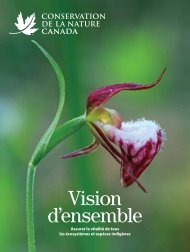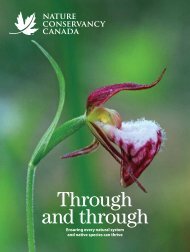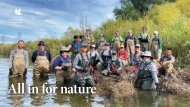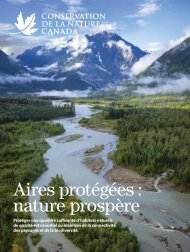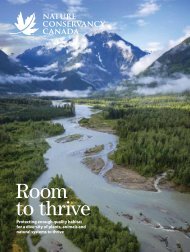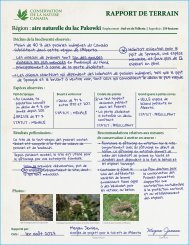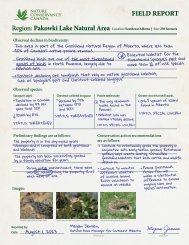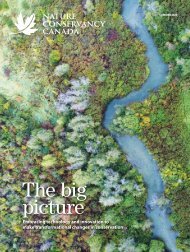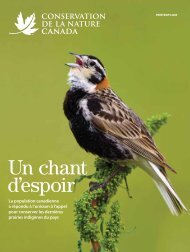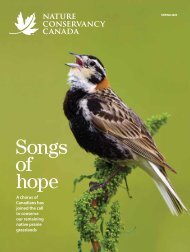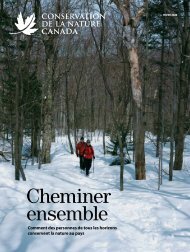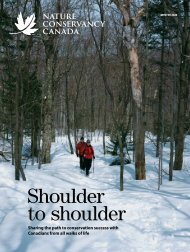Create successful ePaper yourself
Turn your PDF publications into a flip-book with our unique Google optimized e-Paper software.
Driving along a one-way road in Pinery Provincial Park,<br />
Ontario, with a colleague in 2009, Sheila Colla spotted<br />
a bumble bee in the roadside weeds that looked different<br />
from others she had seen that day. Sure enough, it was a rare<br />
rusty-patched bumble bee. But it was also the last individual<br />
of its kind observed in Canada.<br />
“It was exciting at the time — my first drive-by identification, but it’s<br />
sad, as I haven’t found any since then,” says Colla, a pollinator conservation<br />
researcher at York University, in Toronto, Ontario.<br />
Native bumble bees are rapidly declining and some are at risk of<br />
being lost from Canada. Recently, the Nature Conservancy of Canada<br />
(<strong>NCC</strong>), with funding from The W. Garfield Weston Foundation and<br />
Mitacs, supported Colla’s research into pollinator-friendly management<br />
practices in agricultural landscapes. Between 2016 and 2018,<br />
Colla’s team identified the presence of many species of native pollinators<br />
on <strong>NCC</strong> properties, including three species of bumble bees that<br />
are rapidly declining (American bumble bee, yellow-banded bumble<br />
bee and golden northern bumble bee).<br />
“I’ve been researching native pollinators for 15 years, documenting<br />
the decline of native bumble bees in Canada and the U.S., before it was<br />
on the public’s radar,” says Colla. “Often when people talk about pollinator<br />
decline, it’s about non-native honey bees and agricultural crop pollination.<br />
According to a national poll, roughly half of Canadians believe<br />
the European honey bee is a native, wild bee in Canada. But I work<br />
with our native bees, thinking about how to conserve their biodiversity<br />
and the importance of doing so for ecosystem resilience in light of<br />
climate change.”<br />
Art may be a more effective tool to<br />
convey the benefits of pollinators than<br />
a scientific paper.<br />
these culturally important native plants, their<br />
pollinators and what threats they encounter,”<br />
says Colla. She adds that scientists need to<br />
be open to incorporating different knowledge<br />
systems into their research and recognize<br />
that humans are part of the natural world.<br />
Colla and Myers hope their project will<br />
help share Traditional Knowledge about<br />
Indigenous medicine plants and pollinators,<br />
including bees, that evolved alongside them.<br />
“I’m interested in how these gardens<br />
are changing the landscape to more closely<br />
resemble what was there pre-colonization<br />
or settlement,” says Myers. “I hope to raise<br />
conversations about ecology as it relates<br />
to colonization, develop relationships with<br />
people who knew Mike and invite artists to<br />
respond to these gardens with their artwork.”<br />
Colla hopes that the gardens become<br />
spaces for people to observe Canada’s diversity<br />
of wild pollinators. “[The gardens are]<br />
where people can be a part of the ecosystem,<br />
appreciate and learn about plant-pollinator<br />
relationships and our connections to them.<br />
And through that learning we can get people<br />
to care about our native pollinators before<br />
more of them are at risk of extinction, like the<br />
rusty-patched bumble bee is,” she says.1<br />
KITCHENER-WATERLOO ART GALLERY.<br />
Colla finds it challenging to communicate the value of conserving<br />
native pollinators to the public, as it’s often hard to understand how<br />
they positively impact humans.<br />
She believes that art may be a more effective tool to convey the<br />
benefits of pollinators than a scientific paper. And this is where her<br />
collaboration with Lisa Myers, an artist and curator of Anishinaabe<br />
ancestry, takes root.<br />
Colla and Myers are colleagues in the Faculty of Environmental<br />
Studies at York University. They’ve embarked on a unique research<br />
project — Finding Flowers — to replant the late (1941–2006)<br />
Mi’kmaq artist Mike MacDonald’s gardens across Canada.<br />
The first garden in the series is located outside the Kitchener–<br />
Waterloo Art Gallery in Ontario. This striking circular garden features<br />
seven sections and a wooden teepee overhead. The Indigenous medicine<br />
plants growing there support pollinators from spring to late fall,<br />
showcasing the connections between pollinators, traditional medicinal<br />
plants and Indigenous culture.<br />
“[Through Finding Flowers], we hope to integrate ecological studies<br />
and Indigenous art, and gather basic ecological information about<br />
Medicine and Butterfly<br />
Garden (2019),<br />
Mike MacDonald<br />
Kitchener-Waterloo<br />
Art Gallery<br />
natureconservancy.ca<br />
SPRING <strong>2020</strong> 17



